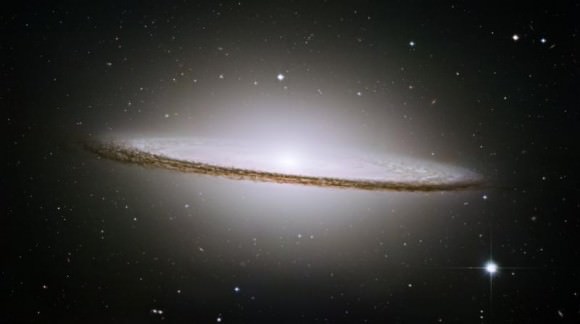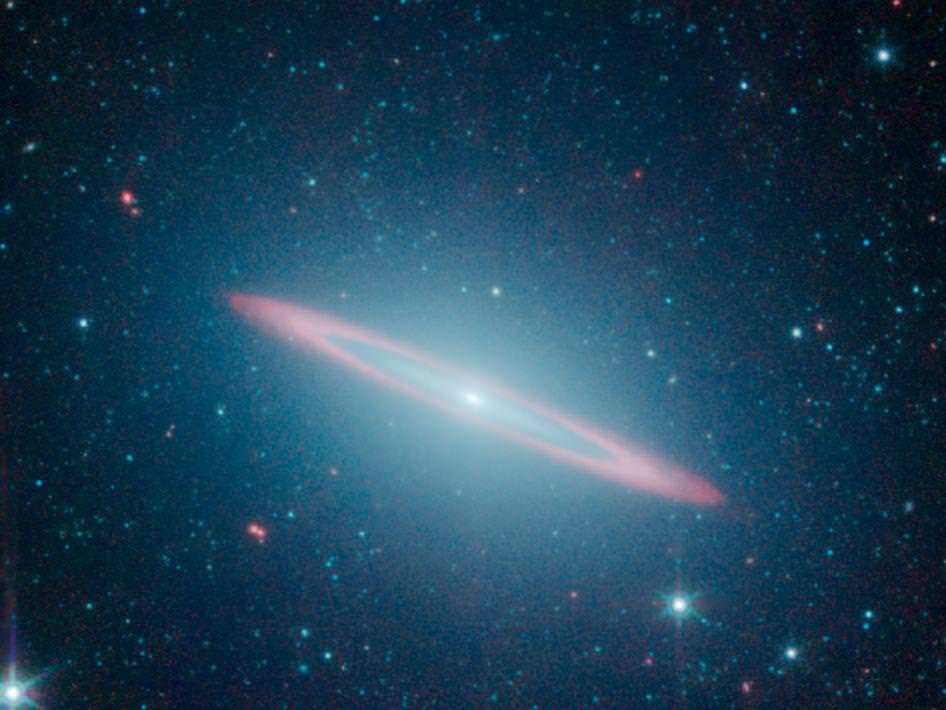[/caption]
The Sombrero galaxy has a split personalty, according to recent observations by NASA’s Spitzer Space Telescope. Infrared imaging has revealed a hazy elliptical halo of stars enveloping a dual-structured inner disk; before this, the Sombrero galaxy was thought to be only disk-shaped.
Spitzer’s heat-seeking abilities reveal both stars and dust within the Sombrero galaxy, also known as Messier 104 and NGC 4594. The starlight detected at 3.5 and 4.6 microns is represented in blue-green while the dust imaged at 8.0 microns is shown in red.
In addition, Spitzer discerned that the flat disk within the galaxy is made up of two sections — an inner disk composed almost entirely of stars with no dust, and an outer ring containing both dust and stars.
The galaxy’s dual personality couldn’t be so clearly seen in previous visible-light images.

“The Sombrero is more complex than previously thought,” said Dimitri Gadotti of the European Southern Observatory in Chile and lead author of the report. “The only way to understand all we know about this galaxy is to think of it as two galaxies, one inside the other.”
Although it might seem that the Sombrero is the result of a collision between two separate galaxies, that’s actually not thought to be the case. Such an event would have destroyed the disk structure that’s seen today; instead, it’s thought that the Sombrero accumulated a lot of extra gas billions of years ago when the Universe was populated with large clouds of gas and dust. The extra gas fell into orbit around the galaxy, eventually spinning into a flattened disk and forming new stars.
This is one of the first galaxies to be seen with such a dual structure — even though M104 has been known about since the mid-1700s.
“Spitzer is helping to unravel secrets behind an object that has been imaged thousands of times,” said Sean Carey of NASA’s Spitzer Science Center at CalTech. “It is intriguing Spitzer can read the fossil record of events that occurred billions of years ago within this beautiful and archetypal galaxy.”
At a magnitude of +8, the Sombrero galaxy is just beyond the limit of naked-eye visibility but can be seen with small telescopes (4-inch/100 mm or larger). It is 28 million light-years away and can be found in the night sky located 11.5° west of Spica and 5.5° northeast of Eta Corvi.
Read more on the NASA press release here.


That marvelous image calls to mind the title of one of the first SiFi books I read as a kid:
“The Stars Like Dust” by Isaac Asimov
The HST high-resolution Image of M104 has been a favorite for years. Perhaps because its tilt emphasizes the Galaxy’s “three-dimensional structure.” The 2,000 Globular Clusters swarming around the “large luminous Bulge” – 10 times more than our Milky Way (yet it is “slightly smaller”!) – is another intriguing feature of this beautifully defined Virgo-Cluster Galaxy.
Could there be some inexplicable relationship between the host of Star Spheres circling about the large Halo, and the dual Disk-Structure? Separate, unrelated parts, or integrated segments of a whole?
Here’s a splendid visible HST Image of that magnificent Island Universe (high-lighting the Disk)!
http://apod.nasa.gov/apod/ap080308.html
Might the vast numbers of globular clusters in M104 represent the last fragments and remnants of a former population of dwarf galaxies, since subsumed by the giant galaxy? Perhaps the last traces of a former dwarf galaxy have been detected as a tidal stream, extending 100,000 parsecs from M104: http://www.pbase.com/strongmanmike2002/image/126173938
Mike Sidonio also has an interesting graphic with information about some of the globular clusters in the halo of M104: http://www.pbase.com/strongmanmike2002/image/125755939
Thanks for GC graphic-link. Wow! They are more widely spread-out than I had realized; in fact they
appear to swarm around the entire visible Galaxy. Perhaps, yet another unusual feature – and clue.
A “remnant”(?) tidal stream is interesting. I was not aware of it. As for the jeweled array of ornamenting Clusters being dwarf-galaxy remains, from my frame of reference, I tend to doubt it. And the system appears too neat: the general distribution of G. Cs seems too evenly-spaced. One tidal stream, in contrast to 2,000 remnant spheroid star systems, all in the same(?) stage?
This seems to indicate a lack of understanding about the evolution of galaxies.
LC